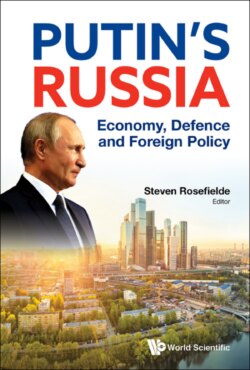Читать книгу Putin's Russia - Группа авторов - Страница 6
На сайте Литреса книга снята с продажи.
Preface
ОглавлениеThe American intelligence and academic communities had a deep understanding of the Soviet Union during the Cold War. Both employed advanced methodologies, including adjusted factor cost national income accounting (pioneered by Abram Bergson, head of the Russian Division of the Office of Strategic Studies), input–output tables (Wassily Leontief), linear programming and econometrics. The Defense Intelligence Agency (DIA) provided satellite photographic reconnaissance (national technical means). Independent analysts had access to unclassified versions of the DIA’s and CIA’s series in compendia published annually by the Joint Economic Committee of Congress. The published and secret numbers were the same.1 The CIA hosted conferences for independent experts. It tutored specialists on the Agency’s methodologies and assumptions and was open to dialogue with the DIA, State Department, Arms Control and Disarmament Agency (ACDA), the Department of Commerce and foreign institutions. The White House sponsored scientific exchanges under the auspices of the US–USSR Science and Technology Agreement (May 24, 1972). The Defense Department, State Department and ACDA had high-level technical exchanges with the Kremlin political establishment and the Soviet General Staff (genstab). It was not treasonous to collaborate with Soviet authorities and émigrés.
President Gerald Ford appointed Steven Rosefielde as coordinator of the US–USSR programme on the application of computers to management with the Central Economics and Mathematics Institute (TsEMI Moscow) under the US–USSR Science and Technology agreement in 1975.2 He worked with Vitaly Shlykov (Co-Chairman of the Russian Defence Council), Valery Makarov (Director of the Central Economics and Mathematics Institute (TsEMI)), Vladimir Bezrukov (Director of Gosplan’s main computing centre), academician Yuri Yaremenko (Director of the Institute of Economic Forecasting of the Academy), Emil Ershov (Director of the Audit Division of the State Statistical Agency), George Kleiner (TsEMI), Stanislav Shatalin (author of the 500 Days Transition programme), Igor Birman (Director of Enterprises in the Construction Materials Ministry), Aron Katsenelinboigen (Head of the Department of Complex Systems, Central Economic-Mathematical Institute, U.S.S.R. Academy of Sciences, 1966–1973) and Boris Yeltsin’s adjutant Lieutenant-General Viktor Samoilov. On the Western side, he collaborated with Patrick Parker (Assistant Secretary of Defense for Intelligence), Andrew Marshall (Head of the Office of the Secretary of Defense), William van Cleave (Director of the Department of Defense Transition Team between the administrations of President Carter and President Reagan), George W. Bush (Director of the CIA and Vice President), Bobby Ray Inman (Director of the CIA) and Robert Gates (Director of the CIA).
The high-level interactions between the academic community and government policymakers in America, Russia and across the globe gave all concerned a realistic understanding of Soviet achievements and potentials that placed sensible boundaries on public discourse. Journalists and activists could spout whatever nonsense they pleased about Soviet’s intentions and capabilities, but their claims had little influence on decision-makers if they were unsupported by data from the CIA and DIA.
The Joint Economic Committee reports on the Soviet Union painted a positive picture of the Kremlin’s health, but one constrained by “growth retardation” that seemed to preclude the Kremlin from catching up with and overtaking America. Conservatives and progressives both found solace in this judgement. It provided evidence for the claim that markets were superior to plans, without rejecting the possibility that socialism might ultimately prove its metal, and it also suggested that the Soviet military threat was manageable. In the interim, the West needed a strong deterrent until either the numbers changed or arms control and disarmament proved a viable alternative.
Most government and academic human capital accumulated in the West for the rational assessment of Soviet potential and prospects no longer exist. Interest in Russia gradually declined. The CIA ceased being the primary monitor of Russia’s economic performance, a role reassigned to the World Bank and International Monetary Fund (IMF), jointly responsible for guiding post-Soviet nations from central planning to democratic free enterprise. The Joint Economic Committee of Congress stopped publishing annual reports on Russia’s performance and prospects. The DIA continues to monitor Russian defence activities, but primarily for internal use. This has provided a green light for journalists and politicians to concoct narratives without fear of authoritative rebuke. Russia’s performance and potential for them is whatever they want it to be, and the public is largely at their mercy. Progressives today seem mostly concerned with blaming Hillary Clinton’s defeat on the Kremlin cyberwar, while conservatives worry about Russian expansionism. Most people seem to believe that steadfast application of economic sanctions will suffice to keep the bear at bay. They cannot fathom the possibility that the Kremlin, powered by its new market economy, has become a formidable authoritarian global rival impervious to slap-on-the-wrist economic sanctions.
This book seeks to fill the vacuum created by the Joint Economic Committee of Congress’s decision to cease publishing comprehensive assessments of Russia’s performance and potential. It provides readers with authoritative descriptions of Russia’s economy, military prowess and international ambitions. This book does not settle controversies, but does provide readers with an objective basis for assessing Russia’s prospects without the distortions caused by fake news and disinformation wars.
______________________
1 Steven Rosefielde, False Science, Underestimating the Soviet Arms Buildup, Transaction, 1982 (Expanded Second Edition, 1987).
2 Coordinator of the US–USSR Joint Cooperative Research Program on Science and Technology (between the National Science Foundation and the Soviet Academy of Sciences), Topic 1, subtopic 3, “enterprise modelling,” 1977–1981.
